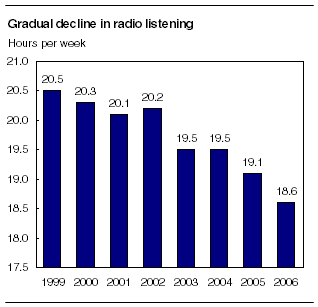
OTTAWA – If the level of radio today’s teenagers now listen to stays consistent as they age, the long-term future of radio appears a little bleak.
Numbers released today by Statistics Canada show that overall, Canadians devoted less time listening to their radios as a form of entertainment in 2006 than in previous years (see chart below), especially teenagers and young adults, many of whom appear to be switching to digital music players and online music services.
"On average, Canadians tuned in to their radios for 18.6 hours during ‘measurement week’ in fall 2006, down from 19.1 hours a week in 2005. Since the fall of 1999, when radio listening peaked, this average has dropped by nearly two hours," says the Statscan release.
In 2006, much of the decline occurred in two age groups: teenagers aged 12 to 17 and young adults aged 18 to 24
Teenagers listened to their radios barely 7.6 hours a week, the lowest of all age groups. This was down from 8.6 hours in 2005 and 11.3 in 1996, showing an accellerating rate of decline.
Among young adult men, listening fell from 15.1 hours to 13.7. Among their female counterparts, it slipped from 15.4 hours to 14.6.
"The popularity of digital music players and online music services had the biggest impact on the radio listening habits of teens and the young adult crowd," says Statscan.
Senior women continued to be the most ardent radio listeners, tuning in for 22.7 hours per week, virtually unchanged from 2005. Among senior men, listening edged down from 20.3 hours a week to 19.5.
The Canadian Broadcasting Corporation (CBC) was the most popular listening format for both senior men and senior women.
It was least popular among young adults.
Radio listening increased in only three provinces in 2006: Newfoundland and Labrador, Nova Scotia and New Brunswick. Residents of Nova Scotia were the most avid listeners, tuning in for 20.4 hours a week, 3.5 hours more each week than their counterparts in British Columbia, where listening was at a nationwide low of 16.9 hours.
The largest declines occurred in Saskatchewan, Prince Edward Island and Quebec. Listening among francophone Quebeckers slipped by a full hour a week. However, their anglophone counterparts tuned in to English-language radio for 20.8 hours a week, the highest level among the provinces.
Listeners in Nova Scotia and Prince Edward Island were a close second and third to anglophone Quebeckers.
As far as music formats are concerned, adult contemporary music captures over a fifth of nation’s listening time, which may be a revealing point as to why teens and young adults don’t listen as much.
In the fall of 2006, this station format captured 22.3% of Canadians’ listening time, followed by gold/oldies/rock (13.9%). The adult contemporary format was the first choice of listeners in New Brunswick, Quebec and Ontario.

The CBC rebounded to third place in overall format ranking in 2006, with an 11.6% share of the total listening audience.
In fourth and fifth places were talk radio and country, each capturing about one-tenth of total audience share. Dance music, a younger format, was dead last in listening, capturing a grand total of 0.5% of the Canadian audience.
The radio project of the Culture Statistics Program is a joint endeavour of the CRTC, the Department of Canadian Heritage, and Statistics Canada.
The Statistics Canada radio listening data bank integrates files from a variety of sources. The basic listening data are acquired from BBM Canada and include demographic characteristics of survey respondents. The information on specific radio station formats is provided by the CRTC.
While the return rate for these numbers, 42.5%, is modest by Statistics Canada standards, it is in line with Canadian and international broadcasting industry practices for audience measurement. However, the data should be interpreted with caution, says the release.



